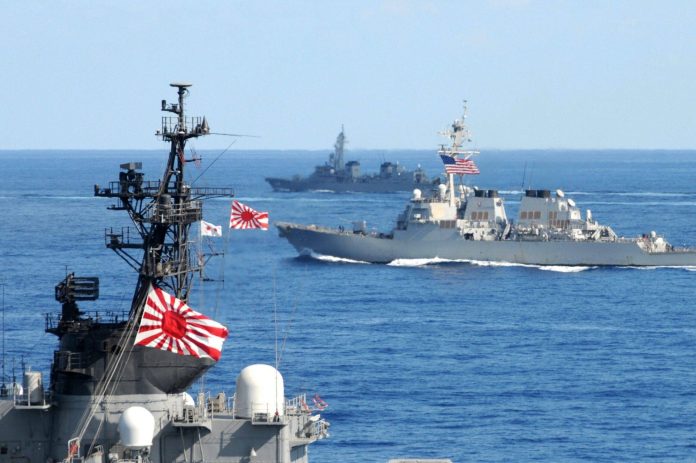The Japanese government is gearing up to deploy submersible drones by fiscal 2030 as part of a comprehensive strategy aimed to bolster the nation’s undersea surveillance and alert systems, reveals a document obtained by The Yomiuri Shimbun.
The plan, according to the reports, is pivotal for keeping a close eye on “China’s ocean advances.”
The strategy, formulated to fortify Japan’s ocean policy, outlines ambitious goals, including the development of unmanned underwater vehicles capable of autonomously navigating beneath the waves.
The plan, which envisions transforming Japan into a “true ocean-resource state,” underscores the collaboration of various government offices and ministries in executing crucial missions.
The strategy’s key objectives encompass diverse areas. The document delineates plans for undersea mining of rare earth and earmarks research initiatives around Minami-Torishima island, a remote outpost within the Ogasawara island chain under Tokyo’s administration.
More, the strategy aims to commence rare earth production as early as fiscal 2028, potentially reducing Japan’s reliance on external sources for these critical minerals.
Additionally, the strategy contemplates the establishment of systems for installing offshore wind power generation facilities within Japan’s exclusive economic zones.
The plan aligns with Japan’s broader renewable energy goals while tapping into the abundant wind resources available at sea.
Further, the document underscores the necessity of developing efficient data acquisition systems for remote territorial islands situated near national borders. This move is crucial for enhancing Japan’s maritime domain awareness and safeguarding its territorial integrity.
According to the report, the outline of the strategy was approved by the ruling Liberal Democratic Party during a meeting on March 29.
The government aims to finalize the comprehensive strategy by the end of April, which will mark a significant step towards strengthening Japan’s maritime capabilities and asserting its presence in the face of evolving geopolitical dynamics in the Asia-Pacific region.
Why Is Japan Focusing On Underwater Drones?
Recent events have highlighted the effectiveness of underwater drones in modern warfare. In the ongoing conflict between Ukraine and Russia, Kyiv has successfully employed relatively inexpensive sea drones to strike several Russian warships, showcasing the potential of these technologies in asymmetric warfare scenarios.
While the exact capabilities of the submersible drones Japan intends to deploy remain uncertain, previous reports suggest that Tokyo aims to develop unmanned underwater vehicles for specific tasks, including laying and sweeping mines.
This effort is aimed at securing maritime dominance in the event of a contingency near the southwestern Nansei Islands chain of the country.
The Nansei Island chain extends southwest from Kagoshima Prefecture to Okinawa Prefecture. This island group encompasses the Senkaku Islands, controlled by Japan but claimed by Beijing, referred to as Diaoyu by China, located in the East China Sea.
Presently, Japan’s Self-Defense Force (SDF) vessels and aircraft are utilized for mine-laying operations. However, there is a concern that adversaries could track these vessels and planes via satellite and other means, which will allow them to pinpoint the location of the mines.
With the deployment of underwater drones, the government seeks to mitigate such risks for the SDF. Simultaneously, it aims to complicate adversary strategies by making it challenging for them to plan invasions using vessels and submarines.
In addition, in February 2024, Japan and Australia announced an agreement to initiate joint research on the future development of underwater drones.
That step marked the first concrete project undertaken by the US allies since they signed a deal in June 2023 to streamline procedures for collaborative technical studies on defense equipment, as confirmed by the respective governments of both nations.
Nonetheless, Tokyo’s strategic prioritization of underwater drones possibly stems from one of the interesting insights gleaned from the Ukraine conflict, which has spurred countries worldwide to consider integrating similar technologies into their military capabilities.
Following Russia’s commencement of the invasion of Ukraine, Japan in December 2022 released its 2022 National Defense Strategy, which emphasizes the prioritization of developing unmanned platforms.
The effective deployment of US unmanned platforms to Misawa, Yokota, and Kanoya Air Bases serves as evidence of Tokyo’s endorsement of extensive drone operations from Japan.
Japanese defense planners, recognizing the significance of underwater drones in maritime strategy, are increasingly exploring smaller “attritable” platforms to penetrate China’s anti-access, area-denial bubble.
These cost-effective and disposable underwater drones can be acquired in larger quantities, which will offer Japan enhanced capabilities in contested maritime environments.









































